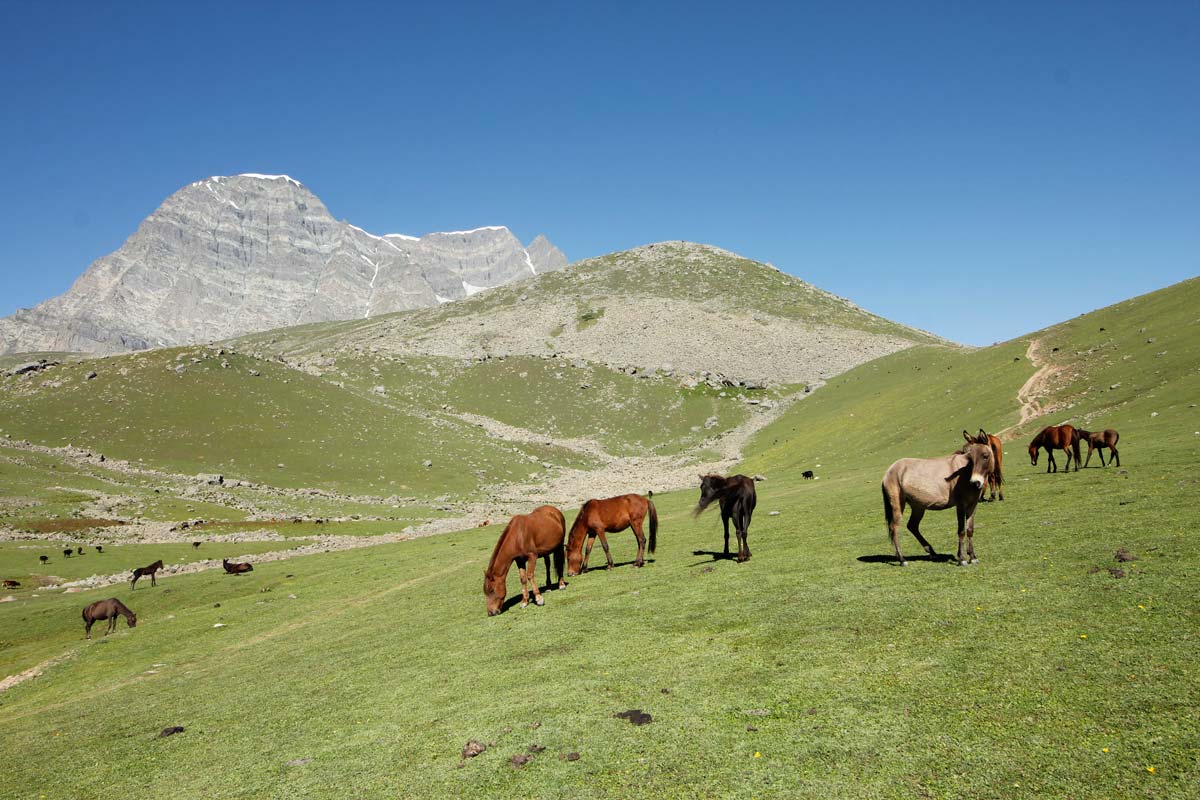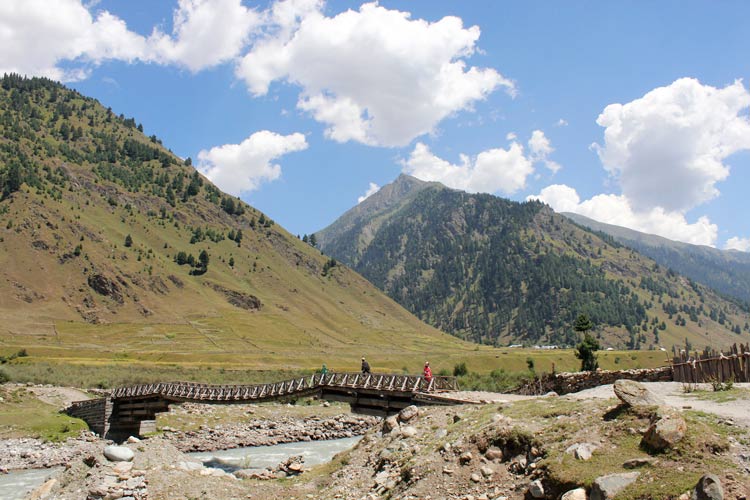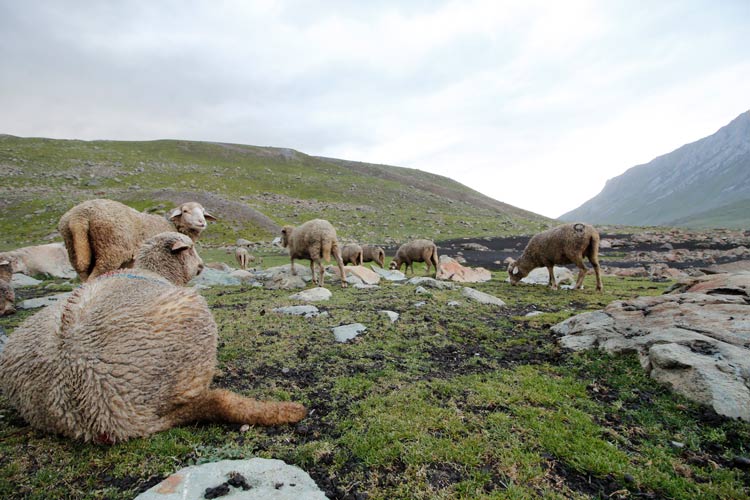
With Covid-19 leading to lockdown in most of the cities across the globe, many people have been confined to their homes with little physical activity to do, leading to mental fatigue.
While many have found this to be debilitating, such an experience is nothing new for the natives of this Himalayan region in the valley of Kashmir, administered by India partially, which often is in the international headlines for its months-long shutdowns and curfews against the Indian rule. The youth here often turn to the mountains.
Those who live in this bowl-shaped valley of Kashmir are surrounded by different mountain ranges, such as the Pir Panjal Range on the southwest and the main Himalayas range on the northeast. The valley also features highland pastures and meadows, high ice-capped peaks and semi-freezing ice-cold alpine lakes originating from the large glaciers. The untouched beauty is comparable to the Alps and can be enjoyed at half the cost of trekking to European destinations.
Trekking in the Kashmir Valley
During this time of the pandemic, the easing up of lockdown has allowed hundreds of natives to head toward different highlands of the region for hiking and mountaineering. Hiking and trekking have become a favorite getaway for Kashmiris, especially during the past decade because of the establishment of many new private adventure clubs and groups.
There are hundreds of mountain passes and trekking options all across the valley, but among the most notable trails are Kishtwar-Kargil trek, which crosses through two different regions of Jammu and Ladakh, and another trekking route from Sonamarg to Kangan, which comprises the Great Lakes Trek.
Even though hundreds of trekkers take two to three-day brief expeditions mostly during the summer months, the above-mentioned trails stretch up to six-to-seven days, with hikers experiencing varied landscapes and multiple alpine lakes. There are trained guides available and trekking clubs that can help tourists with logistics.
These trails have generated a keen interest among the adventure lovers from the plains of India who come to the valley to take up these hikes. Foreign tourists are few in number, but the place and the people are hospitable and the warmth of the homes is always offered to any tourist.
Kishtwar is a mountainous high-altitude district in the southeast of the Kashmir valley and is located in the mountains between Kashmir and the sub-tropical Jammu region of the state. Most parts of the Kishtwar district are remote places with no or little road access.
Kishtwar Kargil Trail
The Kishtwar Kargil trail is popularly known as Kishtwar (Jammu Region) Panikhar (Ladakh Region) trek spanning 92 kilometers (57 miles) in length, along which lies an 18-kilometer-long (11-mile-long) glacier called Sagar Nur glacier or Lonvilad Gali (Pass), which is the highlight of the trek.
This trail is completed in a minimum of six days by walking almost nine hours a day. The trek starts from Basmin village, which is the last stop for any kind of vehicular traffic, a dead-end from the Jammu side.
From here, trekkers are engulfed with the enormous beauty of vast valleys with one of the largest and ferocious rivers, Chenab, flowing beside in the Warwan valley. There are several communities of tiny hamlets comprising 20-30 houses of Bakarwals (shepherds) a few kilometers apart, which can be accessed by foot only. This trek first leads to Sukhnai village, which is the first stop for any trekking group.
The last stop on the Kishtwar side is Kanital valley, which is surrounded by lofty mountains at an altitude of around 12,000 feet, with the base of Sagar Nur glacier visible from here.
The ascent and descent, which brings a trekker to Ladakh region finally, is completed in about nine hours minimum as the entire glacier is mostly to be treaded by walking over it in a zigzag pattern given the slippery surface, with hundreds of feet of snow buried under your feet.
Sagar Nur glacier is one of the main sources of the Chenab River on the Jammu side, irrigating thousands of villages and also providing clean water before entering into Pakistan, the neighboring country.
The trail finally leads to Panikhar village in Suru Valley in Ladakh, while the trail between Suru Valley and Warwan Valley in Kishtwar is one of the eight ancient trans-Himalayan traverses that connect the Ladakh Himalayas (Suru Valley) to Kashmir Himalayas and is also known as the salt route through which trans-Himalayan traders from Kashmir and Ladakh have passed for centuries.
This trek has a unique distinction of giving a rare opportunity to get a taste of both the stark beauty of Ladakh and the lush green valleys of Kashmir while crossing the 18-km-long (11 miles) glacier through Lonvilad Gali (Pass) as one enters the higher Himalayas from the lower Himalayas, with the trek ending in a beautiful valley of Deonar. The maximum altitude during this trek one can reach is 13,800 feet or 4,200 meters above sea level.
Kashmir Great Lakes Trek
The other long trek in the Kashmir region which attracts not only locals but thousands of Indian and foreign trekkers is Kashmir Great Lakes Trek. It is one of the most beautiful treks in the Kashmir valley, with not only dozens of bluish alpine lakes but the high mountain passes like Gadsar and Zajibal that test your endurance.
This trek spans 74 kilometers (46 miles) from Sonamarg to Naran Nag in the Kangan area. The panoramic views, rugged mountains, lush green meadows, vast valleys and multiple alpine lakes are the highlights of this trek.
Gadsar pass, at an estimated elevation of about 4,206 meters (13,800 feet), is the highest point of this trek which overlooks two majestic lakes, Vishansar and Kishansar.
One is mesmerized viewing the pristine lakes nestled in the Gadsar valley, which are fed by huge glaciers. After completing the Gadsar trail, trekkers reach another valley, Satsar, where one can have a glimpse of seven different alpine lakes nestled in the mountains. All these valleys rise above 3,350 meters (11,000 feet), with most of the trek above the tree line.
The last most-difficult pass one has to cross is the Zajibal pass at an altitude of 4,100 meters (13,450 feet). As one reaches the top of the pass, the entire view opens into the Gangbal valley, with Harmukh peak, some 5,142 meters (16,870 feet) above sea level, in the background, the second-highest peak of the Kashmir valley. Two vast, sparkling lakes, Gangbal and Nundkol, are settled under the foothills of Harmukh Peak.
Author Bio: Shafat Mir is a multimedia journalist, based in the southern district of Anantnag (Islamabad) in the Indian-administered Kashmir and has been covering happenings for several local English dailies besides having worked for an online community-based video news service for a large part of his career. He holds master’s degrees in mass communication and journalism from the Kashmir University and is an avid trekker and a nature lover who started hiking during his school days.
- Life of a Champion: Exploring the Muhammad Ali Center in Louisville - April 19, 2024
- What It’s Like to Live as an Expat: Lake Chapala, Mexico - April 18, 2024
- Top 5 Spots for Stargazing in North Carolina - April 17, 2024




















Keep up the good work
Excellent article . Thanks for covering one of the best places to trek in the world. The pics give a good context to the places and people you have covered. Hope to see much more such coverage from you.